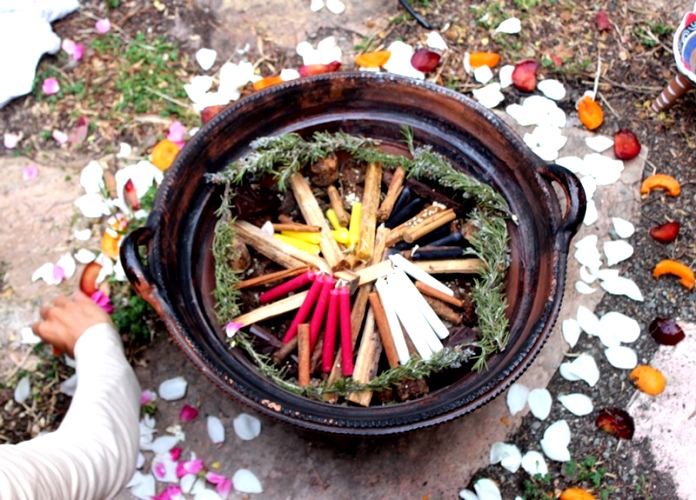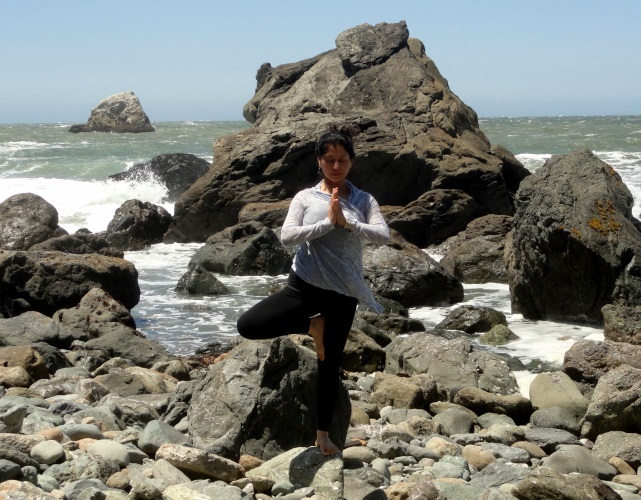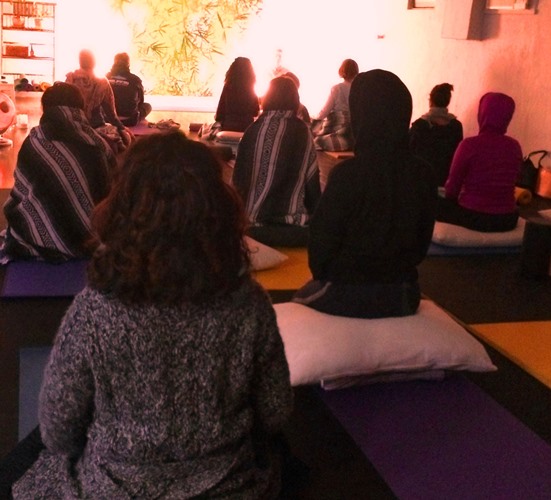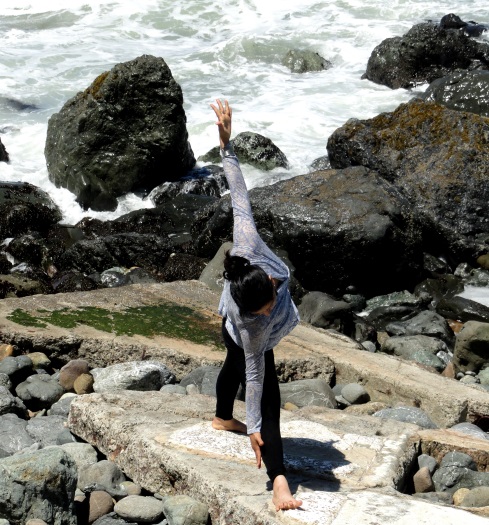By Lilia Roman

Trauma is real, prevalent, and affects all aspect of our lives. Yoga offers us powerful tools that can help us heal its overwhelming effects and transform the way we see ourselves and the way we live our lives. Some indigenous cultures view trauma as the loss of the soul, caused by an overwhelming experience that leaves the person unable to experience a sense of self, love, joy and connection with his/her world. Psychotherapists today define trauma as an experience that robs us of our power to be and live in a proactive way and leaves us feeling hopeless and helpless. Although I am not a psychotherapist and do not have the knowledge or expertise of a trauma specialist, I understand from experience that the body carries history and, left unattended, this history will continue to affect our lives. The majority of people have had traumatic experiences. Many have lived through physical or sexual abuse, alcoholism, family separation, uprooting, accidents, social discrimination, or other types of physical and emotional pain.
I became a yoga teacher when I realized that the practice of Yoga can be used as a tool to reintegrate the self and help us find our inner power, self-esteem, confidence, and the love we lack within ourselves. It can give us the daily resources to help us reconnect to our bodies by bringing awareness to our sensations, and by helping us develop a deeper sense of being and belonging. Indeed, in Yoga we have a powerful practice to help us cultivate the heart’s amazing capacity to love and the body’s great capacity to heal, while using simple, gentle methods.
Today Yoga is being widely used in clinics to help heal the emotional wounds trauma may leave in our bodies. Much research has been done to prove the benefits of Yoga. This research has found that Yoga can give us the tools to find the softness and compassion we need towards ourselves, and the resiliency to navigate life’s upheavals and challenges.
In our modern, dysfunctional world, with its constant challenges and growing loneliness, many suffer from some kind of mental instability, neurosis, and unreleased pain. People are affected in a variety of ways due to innate predispositions as well as to their external environment.
Trauma in Our Modern World
Dr. Bessel Vander Kolk, founder and medical director of the Trauma Center in Brookline, Massachusetts, asserts that one does not have to be a combat soldier, or visit a refugee camp in Syria or the Congo to encounter trauma. “Trauma happens to all of us, our friends and neighbors: one in five Americans was molested as a child; one in four was beaten by a parent to the point of a mark being left on the body; one in three couples engages in physical violence…”[2] , or as Dr. Peter Levine, director and originator of Somatic Experiencing, explains “Most of us have been traumatized, not just soldiers, or victims of abuse or attack. Both the sources and consequences of trauma are wide-ranging and often hidden from our awareness. These include natural disasters, accidents, falls, illness, sudden loss”[3]. In order to heal trauma, the first thing we need to do is acknowledge it. Denying trauma is denying our fears, our vulnerability, and our history, with its struggles and the roots of many of our problems.
‘Trauma represents animal instincts gone awry”, says Dr. Levine in his book ‘Walking the Tiger, Healing Trauma’, and until we understand that the symptoms are physiological as well as psychological, we will not be able to heal them. When faced with a threat, animals have two reactions: they may run away from danger, given the opportunity, or they instinctively go into the “freeze” or “immobility” response. If they choose the latter and survive the event, they go into the shaking mode after the threat has passed, releasing stagnated energy held during the “freeze” response. Humans rarely allow themselves to release the tension after an overwhelming event. “Muscle tension and feelings of disconnectedness in the affected body areas are ways in which helplessness is stored in the body. People with stored trauma will try to reject unwanted sensory experiences and may become numb, rigid, and tight[4].” “At least half of all traumatized people try to dull their intolerable inner world with drugs, alcohol…”[5]. Individuals may become obese or anorexic, or develop some type of addiction, including, among other things, to exercise, work, food and sex.
Unfortunately, in modern, patriarchal-based societies, acknowledging trauma is viewed as weak and unproductive. We learn to admire toughness, competition, and our ability to “move on”, pretending to be in control. We are ashamed to confront our own pain and honor our sensitivities. When one has experienced a traumatic event, however, there may be no “moving on”. Left unresolved, trauma will continue to drain a person’s energy and their will to fully inhabit their body: “Traumatized people are unable to overcome the anxiety of their experience. They remain overwhelmed by the event, defeated and terrified. Virtually imprisoned by their fear, they are unable to re-engage in life.”[6]
Trauma compromises the brain area that communicates the physical, embodied feeling of being alive, says Dr. Vander Kolk. That is the reason traumatized people become hypervigilant to threat. This helps us also understand why traumatized people often keep repeating the same patterns and have trouble learning from experience.[7]
The Wisdom of Ancient Healing Practices
Some Mexican indigenous cultures, such as the Nahuatl, teach us that we are nature and that traumatic events are part of our lives. In order to transform them, we must confront our susto, espanto, or shock, with care and compassion. Indigenous Mexican healing practices are not afraid to address the problem and to use ancestral practices to bring the person back into a harmonious state of being.

As a child growing up in Mexico, I observed healers making use of plant medicines to heal people from mental and psychological illnesses. These healers understood and accepted their deep connection with the earth and their animal nature. In their view, psychological or mental illnesses meant that the person had been disconnected from nature, the soul had left the body, and the person no longer knew who he or she was. They believed that by making use of the elements of earth, water, fire, and air, the person’s soul could come back to the body. One method to achieve this is by cultivating rituals and practices that can keep us close to the elements, to our animal essence, and to each other.
Dr. Levine asserts that the key to healing trauma in humans lies in our being able to mirror the fluid adaptation of wild animals as they shake out, discharging the energy that has been generated due to the traumatic event, and get through the immobility response to became functional again. “Traumatic symptoms are not caused by the “triggering” event itself. They stem from the frozen residue of energy that has not been resolved and discharged; this residue remains trapped in the nervous system where it can wreak havoc on our bodies and spirits.”[8] Since the roots of trauma lie in our instinctual physiologies, it is through our bodies, as well as our minds, that we can discover the key to its healing. For this, we must connect to and trust our body’s natural, innate intelligence and begin to listen to the body’s story. This could be our greatest, most humbling journey, the journey of a warrior. As, Dr. Levine says: “Each of us must find those roots, realizing that we have the power to choose- perhaps one of the greatest of our lives. Healing of trauma is a natural process that we can access through our inner awareness of our body, not through years of psychological therapy.”[9]
Recognizing the Effects of Trauma
Most of us won’t even recognize the effect of trauma in our own bodies. They can range from loss of skin sensation to physical and behavioral problems that can lead to insomnia, lack of energy, headaches, gastrointestinal problems, and others. “Some of the frightening and often bizarre symptoms suffered by traumatized people include: flashbacks, anxiety, panic attacks, insomnia, depression, psychosomatic complaints, lack of openness, violent unprovoked rage attacks, and repetitive destructive behaviors”.[10] Based on Dr. Levine’s research, as many as seventy-five percent of the people who go to doctors have complaints that are diagnosed as psychosomatic.
The growth of technology has not made it easier for most people. Modern individuals live more in their heads, often disconnected from their bodies and from the body’s natural ability to heal and recover. As a result, trauma is not given its proper place to be truly felt, seen, and explored. Dr. Levine explains that people who are more in touch with their natural selves tend to fare better when it comes to trauma and are able to prevent it or heal faster: “Without easy access to the resources of this primitive, instinctual self, humans alienate their bodies from their souls…Existing in a limbo in which we are neither animal not fully human can cause a number of problems, one of which is being susceptible to trauma”[11]
The Autonomic Nervous System (ANS)
The Autonomic Nervous System is the brain’s survival mechanism and is divided in two branches: the Sympathetic Nervous System (SNS) and the Parasympathetic Nervous System (PNS). Basically, these two branches regulate arousal in the body. The SNS releases adrenaline when it is time for the body to take action, activating the “fight” or “flight” response. The PSN is in charge of the relaxation response, regulating basic body functions like digestion, sleep, and wound healing. When our nervous system is fully balanced, we have a sense of well-being; we are content and engaged with life. There have been very important discoveries on the effects of trauma in our bodies and in the last few years we have seen new areas of study that shed light on the effects of psychological trauma, neglect, and abuse. Dr. Vander Kolk sites three new disciplines: Neuroscience, the study of how the brain supports mental processes; developmental psychotherapy, the study of the impact of adverse experiences on the development of the mind and brain; and interpersonal neurobiology, the study of how our behavior influences the emotions, biology, and mind-sets of those around us.[12]
The findings have been very revealing and show that trauma produces actual physiological changes. These changes include a recalibration of the brain’s alarm systems, an increase in stress hormones and alteration of the system that filters information, which affects the way in which trauma makes people see things “bigger than they are”. Because of this way of seeing things, they can be easily thrown off balance, both mentally and physically, and may exhibit behaviors that may not be due to a lack of sensitivity or morals, but may be caused by changes in the brain. [13]
These studies confirm that trauma has a strong impact on the mind-body relationship. Trauma greatly disrupts people’s ANS and can keep them living in the past, disconnected from their bodies and from a sense of grounding and belonging. As a result they may be unable to make conscious, healthy life choices and may remain trapped in the effects of their overwhelming experience, in fear or in pain. On a recent online interview led by Tami Simon (Sounds True Multimedia Publishing, Co), Dr. Vander Kolk said that traumatized people are involuntarily stuck in multiple levels. It is not a conscious decision. It is a primitive, animal like part of the self that continues to react in an unhealthy way, without knowing why.[14]
What Does It Have to do with Yoga?
Great new findings have also revealed new possibilities to heal and reverse the damage that trauma may have caused. Thanks to the heart rate variability discovery in the 1990s, we can now know how well the ANS is working. Heart rate variability measures the relative balance between the SNS and PNS. Inhalations stimulate the SNS, increasing the heart rate. Exhalations stimulate the PNS, decreasing the heart beats. Balanced inhalations and exhalations have the power to balance the ANS, resulting in good heart variability, which is a measure of well-being.[15]
 Dr. Vander Kolk highlights methods and experiences that utilize the brain’s own natural neuroplasticity to help people re-connect to their bodies in a healthy way and live healthier lives. Although he sites several approaches, he says that one of the avenues to heal trauma is “by allowing the body to have experiences that deeply and viscerally contradict the helplessness, rage, or collapse that result from trauma”.[16]
Dr. Vander Kolk highlights methods and experiences that utilize the brain’s own natural neuroplasticity to help people re-connect to their bodies in a healthy way and live healthier lives. Although he sites several approaches, he says that one of the avenues to heal trauma is “by allowing the body to have experiences that deeply and viscerally contradict the helplessness, rage, or collapse that result from trauma”.[16]
Other findings confirm that yoga, through the practice of body movement, breathing techniques and meditation, can lead people into greater self-awareness and help manage anger, depression, and anxiety. He adds that this practice can also positively affect such wide-ranging medical problems as high blood pressure, elevated stress hormone secretion…[17] Yoga has the potential to transform the feelings of powerless and dissociation by helping people acknowledge what is happening within and to bring them to a state of self-observation, witnessing themselves from a place of a deep sense of well being and grounding. Through this practice, people may viscerally start changing the way they feel, connect, and behave. This is the resiliency that yoga can build, which can help people act with awareness and compassion rather than react with hate and anger.
Trauma can be healed using the body’s innate capacity. Yoga offers us the tools to make the mind-body connection we need. Personally, the physical ailments such as migraines, insomnia, and depression that assaulted me in the past are no longer part of my everyday life. Much of this progress is due to my yoga practice, prayer rituals, and connection to nature.
Good therapists, yoga and meditation teachers agree that our healing depends on our ability to regain connection with our bodies, with rituals and a spiritual life. All we need is to let our natural, biological instincts guide us. In order to do that, first we must begin to cultivate trust in our bodies and the world we live in. “When humans roamed the hills and valleys, gathered roots and berries, hunted wild animals, and lived in caves, our existence was closely linked to the natural world. The life threatening events prehistoric people faced molded our modern nervous systems to respond powerfully and fully whenever we perceived our survival to be threatened…most of us have become separated from our natural, instinctual selves- in particular, the part of us that can proudly, not disparagingly, be called animals.” [18]
Indeed, our healing is greatly linked to our re-connection to our animal self. Reconnection to our bodies through our sensations is very much related to our awareness, sense of safety, well-being, and trust. This is key to healing trauma, as Yoga teachers and therapists such as Dr. Levine and Van Der Kolk suggest. Yoga offers us the skills that are essential for transforming trauma and the way we look at it.
In Sanskrit, Yoga means union, an integration of the body, mind, and inner being. Yoga has evolved into a powerful, methodical approach that, in subtle, gentle ways, helps us reconnect to our true essence and to realize the power of our hearts and bodies. Through the breath and mindful, skillful movement, Yoga can help us release stagnated energy and connects us with the parts of ourselves that remain dormant.

In1994, Dr. Van Del Kolk did a scientific study on PTSD and found that yoga, through simple breath awareness techniques, postures, and meditation significantly improved arousal problems in PTSD. It dramatically improved people’s relationships to their bodies; people started “listening” to their body, and developing love and compassion towards themselves.[19]
The study and practices of Yoga open us to a world of infinite possibilities as it allows us to get new insights about ourselves that are not based on past information and mental conditioning. The objective of Yoga is to be able to quiet the mind and sit in meditation, becoming witnesses to our own selves without attachment; we begin to not be afraid of our bodies and emotions and to meet each moment as it is.
The Asana Practice’s Impact on Our Bodies
In a Yogasana practice, there are certain things that start happening. An experienced yoga teacher will help students connect with their bodies’ subtleties, helping them regain a sense of trust. Students will start acquiring a sensation of grounding and expansion, boundaries, and balance. They will gain resiliency, learn to respond with awareness rather than reactivity, and to see the “big picture”. As spiritual Yoga teacher Richard Miller said: “In Yogic meditation, we are growing a larger capacity for enhancing our abilities to meet the moment, our emotions, and detach and become free from biases, family, and collective conditioning.” [20] Dr. Miller described it as our body learning to see what is important and to live a purposeful life from a deep, strong foundation.
In a Yoga practice, the intention is not to accomplish a pose but to find unity: unity of mind, body and spirit. We locate ourselves in space, connecting to everything that is around us. We develop Proprioception, which is the ability to sense where we are in space. Matthew Sanford, a recognized Iyengar yoga teacher who works with people with disabilities, says: “Asana is just an attempt to move your body more in a way that is congruent with the space around us. Conditions of safety must be met for the subtle body and subtle experience in poses to become more conscious. By reconnecting ourselves with our lower body, our hips, our legs, our feet… connection with the earth will start naturally happening. Yoga is not about accomplishment, but about awareness.”[21]
Since trauma brings us to a physical and emotional state of contraction, in Yoga we start working on expansion, both physically and internally. We use the breath and postures, active and restorative, to lose the fear of expansion and grounding and to notice the pulsation of our bodies. We begin to allow ourselves to be, receive, feel and move on. We are allowing our bodies to viscerally contradict the helplessness, rage, or collapse that result from trauma and also preventing trauma to inhabit our bodies. Yoga gives us the opportunity to dissolve the feeling of victimhood and to achieve greater self-control.

Through the practice, presence begins to happen. We realize that a disconnected mind can travel in all directions. Our intention is to appease the mind and integrate our inner and outer bodies to bring us to a state of meditation. In the process, connection to our breath and body sensations awakens, the mind settles and our body begins to soften from the inside out. We use our practice to reclaim the parts of ourselves that were lost due to trauma and help us become more resilient. We realize that everything is Yoga. This realization can help us see our interconnectedness, regardless of who we are. It is a discipline that keeps evolving and adapting to the times and its needs and has the potential to meet us where we are. Its principles are universal. My students and I continue to receive and appreciate its great benefits.
[2] B. Van Der Kolk, The Body Keeps the Score, Penguin Books (2015):1
[3] P. Levine, Walking the Tiger Healing Trauma, North Atlantic Books (1997):19
[4] P. Levine, Walking the Tiger Healing Trauma, North Atlantic Books (1997): 34-36
[5] B. Van Der Kolk, The Body Keeps the Score, Penguin Books, (2015)
[6] P. Levine, Walking the Tiger, Healing Trauma, North Atlantic Books, (1997): 28
[7] The Body Keeps the Score, Penguin (2014)
[8] Walking the Tiger, Healing Trauma, pg. 19
[9] Walking the Tiger, Healing Trauma, Peter Levine, North Atlantic Books, pg. 34
[10] P. Levine, Walking the Tiger- Healing Trauma, North Atlantic (1997): 44-62
[11] P. Levine, Walking the Tiger – Healing Trauma, North Atlantic (1997):43
[12] B. Van Der Kolk, The Body Keeps the Score, Penguin Books, (2015): 2
[13] B. Van Der Kolk, The Body Keeps the Score, Penguin (2014)
[14] Fluid, Alive and Optimistic, Sounds True Interview, Feb. (2017)
[15] B. Van Der Kolk, The Body Keeps the Score, Penguin, (2014): 269
[16] The Body Keeps the Schore, Penguin, (2014): 3
[17] B. Van Der Kolk, The Body Keeps the Score, Penguin, (2014), 271
[18] P. Levine, Walking the Tiger- Healing Trauma, North Atlantic (1997): 43
[19] B. Van Der Kolk, The Body Keeps the Score, Penguin, (2015): 272
[20] The Shift Network, Art & Science of Yogic Meditation Interview, Feb. 2017
[21] Matthew Sanford on Coming Home – Yoga and Trauma – May 2016


Thanks Lilia for sharing a totally awesome treatise… my mother wrote a diary during the last two years before she died at age 88; titled “My regrets” that began “I was almost killed by my dad even before I was married when he swung a bolo (a sugar cane cutting sized knife) that would have decapitated me had I not ducked: (my grandfather was reacting to being told that my mom was pregnant as a result of an assault by my future father.) Were the impacts of this trauma intricately woven into every cell of the developing fetus?
The operative phrase of your treatise is “Yoga gives us the opportunity to dissolve the feeling of victimhood and to achieve greater self-control.” This backdrop of how Lilia teaches yoga has enabled me to connect the many aspects of body, mind, heart, and spirit that I have discovered in my own personal journey of discovering the deeply buried effects that periodically arise as symptoms of this trauma…necessary to actually follow through with the intent of this phrase. The greatest challenge is to dissolve our lifelong traumas and to actually have our real self BELIEVE THAT IT IS absolutely in control to create intentions to be healed using mind and spirit to develop these intentions, which must then be energized by heart and realized through our will in our physical self. In creating a magnetic center with this BELIEF, our intentions are achieved in a manner that follows how all in the universe materialize.
Thanks, Lilia
Pingback: RELEASING STRESS AND TRAUMA: Restorative Yoga, Aromatherapy, and Herbs